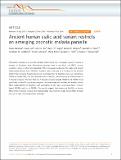Ancient human sialic acid variant restricts an emerging zoonotic malaria parasite
Author(s)
Dankwa, Selasi; Lim, Caeul; Bei, Amy K.; Jiang, Rays H. Y.; Abshire, James Robbins; Patel, Saurabh D.; Goldberg, Jonathan M.; Moreno, Yovany; Kono, Maya; Niles, Jacquin C.; Duraisingh, Manoj T.; ... Show more Show less
DownloadDankwa-2016-Ancient human.pdf (1.286Mb)
OPEN_ACCESS_POLICY
Open Access Policy
Creative Commons Attribution-Noncommercial-Share Alike
Terms of use
Metadata
Show full item recordAbstract
Plasmodium knowlesi is a zoonotic parasite transmitted from macaques causing malaria in humans in Southeast Asia. Plasmodium parasites bind to red blood cell (RBC) surface receptors, many of which are sialylated. While macaques synthesize the sialic acid variant N-glycolylneuraminic acid (Neu5Gc), humans cannot because of a mutation in the enzyme CMAH that converts N-acetylneuraminic acid (Neu5Ac) to Neu5Gc. Here we reconstitute CMAH in human RBCs for the reintroduction of Neu5Gc, which results in enhancement of P. knowlesi invasion. We show that two P. knowlesi invasion ligands, PkDBPβ and PkDBPγ, bind specifically to Neu5Gc-containing receptors. A human-adapted P. knowlesi line invades human RBCs independently of Neu5Gc, with duplication of the sialic acid-independent invasion ligand, PkDBPα and loss of PkDBPγ. Our results suggest that absence of Neu5Gc on human RBCs limits P. knowlesi invasion, but that parasites may evolve to invade human RBCs through the use of sialic acid-independent pathways.
Date issued
2016-04Department
Massachusetts Institute of Technology. Department of Biological EngineeringJournal
Nature Communications
Publisher
Springer Nature
Citation
Dankwa, Selasi, Caeul Lim, Amy K. Bei, Rays H. Y. Jiang, James R. Abshire, Saurabh D. Patel, Jonathan M. Goldberg, et al. “Ancient Human Sialic Acid Variant Restricts an Emerging Zoonotic Malaria Parasite.” Nat Comms 7 (April 4, 2016): 11187.
Version: Final published version
ISSN
2041-1723